LSBM101 - Air Canada: Application of Marketing Principles & Practice
VerifiedAdded on 2023/01/17
|10
|3115
|50
Case Study
AI Summary
This case study provides an in-depth analysis of Air Canada's marketing strategies and principles, examining key marketing concepts, terminology, and their application within the airline industry. It identifies the marketing strategies and programs that have contributed to Air Canada's objectives, considering ethical implications. The study further explains the marketing concepts and principles, such as the 7Ps and STP model, used in Air Canada's daily operations. It also explores the relationship between the marketing function and other functional areas within the organization. The report concludes with recommendations for enhancing organizational effectiveness.
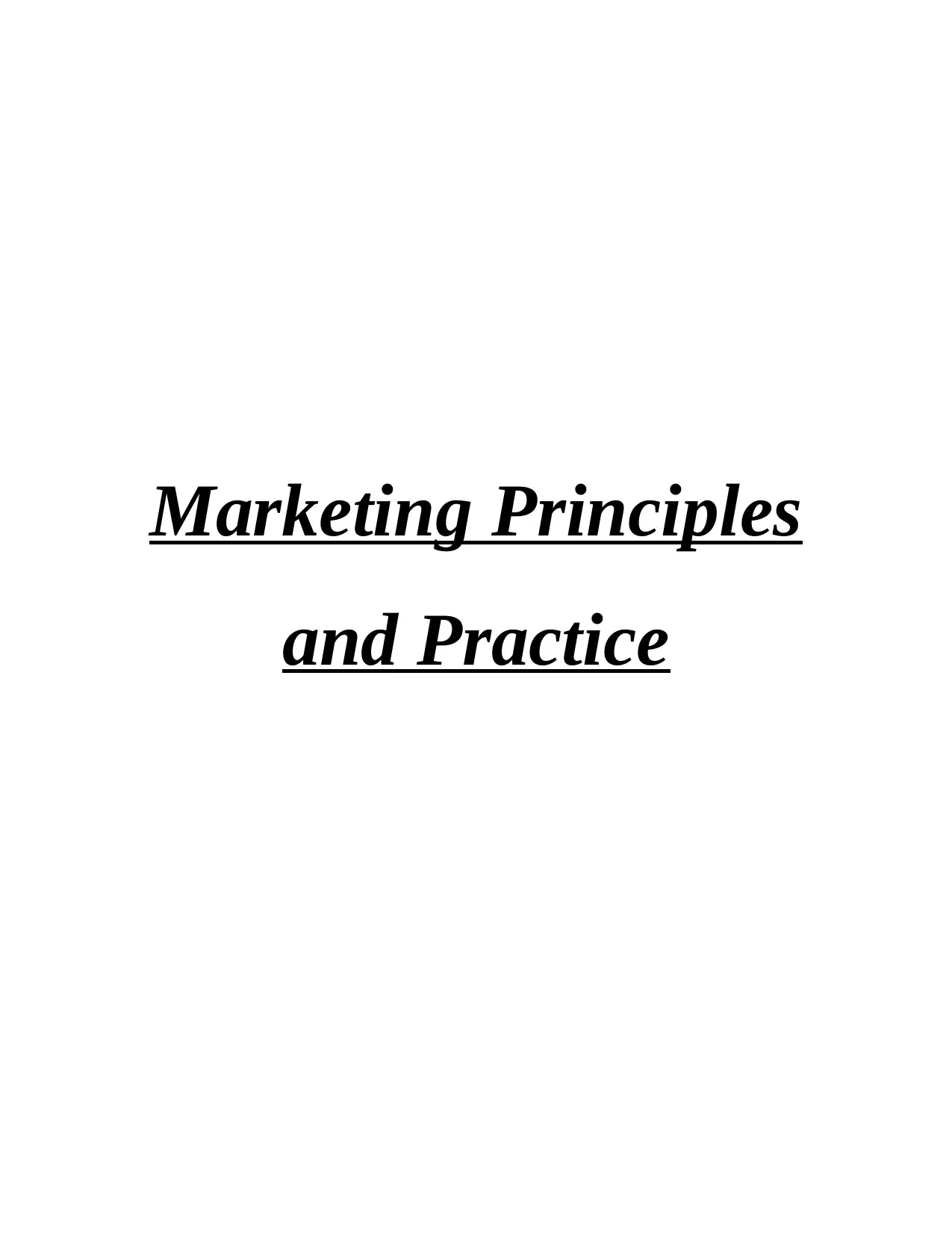
Marketing Principles
and Practice
and Practice
Paraphrase This Document
Need a fresh take? Get an instant paraphrase of this document with our AI Paraphraser
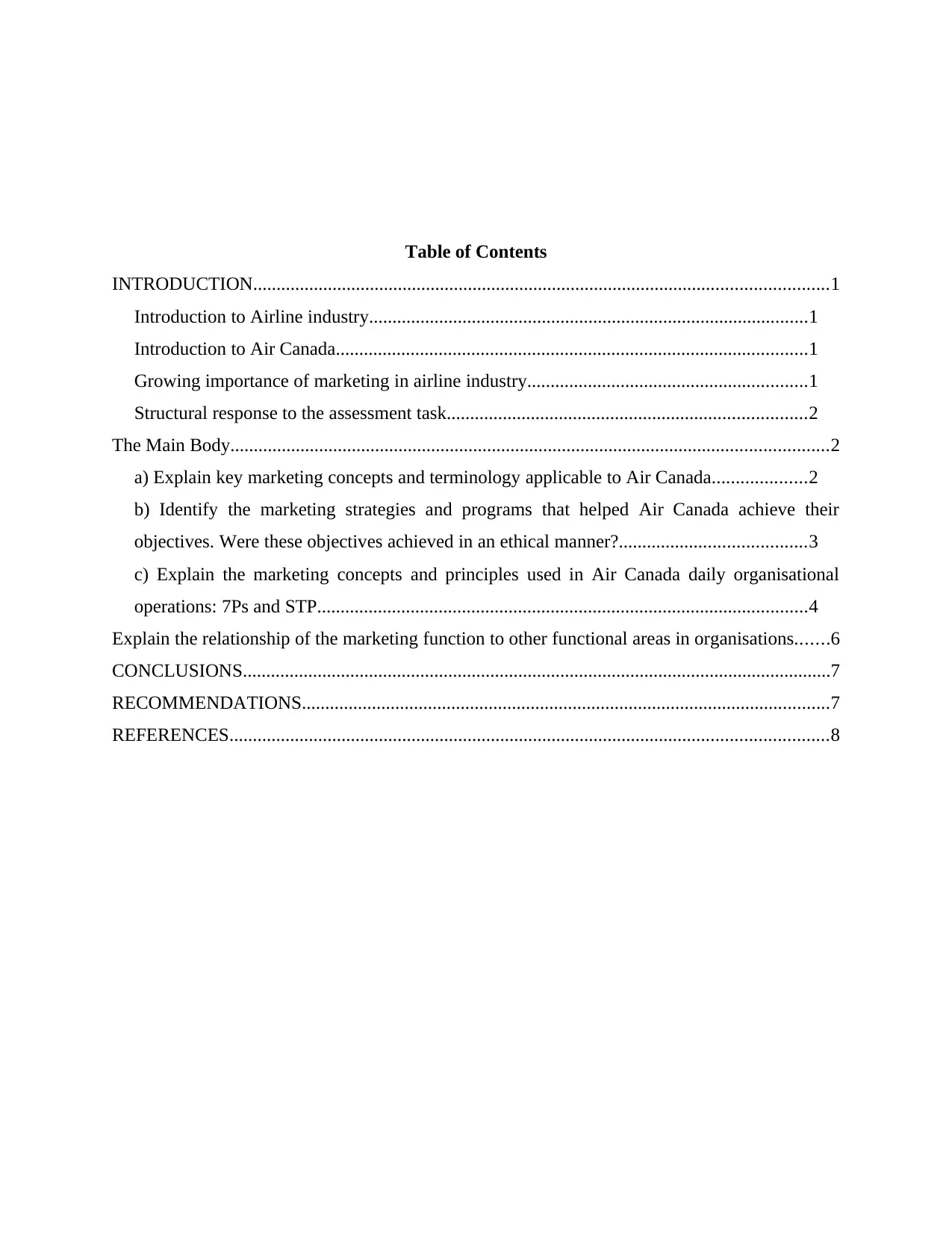
Table of Contents
INTRODUCTION...........................................................................................................................1
Introduction to Airline industry..............................................................................................1
Introduction to Air Canada.....................................................................................................1
Growing importance of marketing in airline industry............................................................1
Structural response to the assessment task.............................................................................2
The Main Body................................................................................................................................2
a) Explain key marketing concepts and terminology applicable to Air Canada....................2
b) Identify the marketing strategies and programs that helped Air Canada achieve their
objectives. Were these objectives achieved in an ethical manner?........................................3
c) Explain the marketing concepts and principles used in Air Canada daily organisational
operations: 7Ps and STP.........................................................................................................4
Explain the relationship of the marketing function to other functional areas in organisations.......6
CONCLUSIONS..............................................................................................................................7
RECOMMENDATIONS.................................................................................................................7
REFERENCES................................................................................................................................8
INTRODUCTION...........................................................................................................................1
Introduction to Airline industry..............................................................................................1
Introduction to Air Canada.....................................................................................................1
Growing importance of marketing in airline industry............................................................1
Structural response to the assessment task.............................................................................2
The Main Body................................................................................................................................2
a) Explain key marketing concepts and terminology applicable to Air Canada....................2
b) Identify the marketing strategies and programs that helped Air Canada achieve their
objectives. Were these objectives achieved in an ethical manner?........................................3
c) Explain the marketing concepts and principles used in Air Canada daily organisational
operations: 7Ps and STP.........................................................................................................4
Explain the relationship of the marketing function to other functional areas in organisations.......6
CONCLUSIONS..............................................................................................................................7
RECOMMENDATIONS.................................................................................................................7
REFERENCES................................................................................................................................8
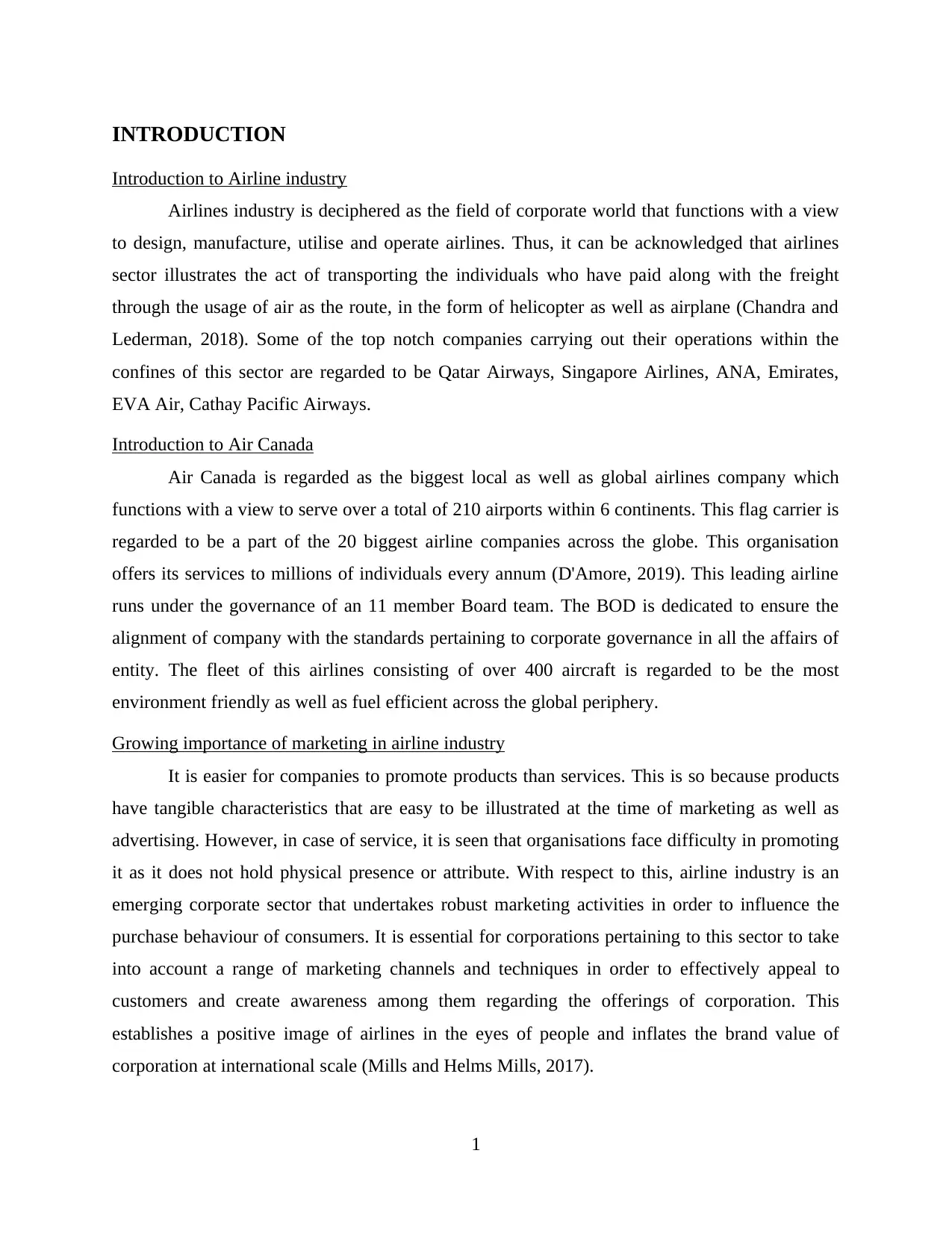
INTRODUCTION
Introduction to Airline industry
Airlines industry is deciphered as the field of corporate world that functions with a view
to design, manufacture, utilise and operate airlines. Thus, it can be acknowledged that airlines
sector illustrates the act of transporting the individuals who have paid along with the freight
through the usage of air as the route, in the form of helicopter as well as airplane (Chandra and
Lederman, 2018). Some of the top notch companies carrying out their operations within the
confines of this sector are regarded to be Qatar Airways, Singapore Airlines, ANA, Emirates,
EVA Air, Cathay Pacific Airways.
Introduction to Air Canada
Air Canada is regarded as the biggest local as well as global airlines company which
functions with a view to serve over a total of 210 airports within 6 continents. This flag carrier is
regarded to be a part of the 20 biggest airline companies across the globe. This organisation
offers its services to millions of individuals every annum (D'Amore, 2019). This leading airline
runs under the governance of an 11 member Board team. The BOD is dedicated to ensure the
alignment of company with the standards pertaining to corporate governance in all the affairs of
entity. The fleet of this airlines consisting of over 400 aircraft is regarded to be the most
environment friendly as well as fuel efficient across the global periphery.
Growing importance of marketing in airline industry
It is easier for companies to promote products than services. This is so because products
have tangible characteristics that are easy to be illustrated at the time of marketing as well as
advertising. However, in case of service, it is seen that organisations face difficulty in promoting
it as it does not hold physical presence or attribute. With respect to this, airline industry is an
emerging corporate sector that undertakes robust marketing activities in order to influence the
purchase behaviour of consumers. It is essential for corporations pertaining to this sector to take
into account a range of marketing channels and techniques in order to effectively appeal to
customers and create awareness among them regarding the offerings of corporation. This
establishes a positive image of airlines in the eyes of people and inflates the brand value of
corporation at international scale (Mills and Helms Mills, 2017).
1
Introduction to Airline industry
Airlines industry is deciphered as the field of corporate world that functions with a view
to design, manufacture, utilise and operate airlines. Thus, it can be acknowledged that airlines
sector illustrates the act of transporting the individuals who have paid along with the freight
through the usage of air as the route, in the form of helicopter as well as airplane (Chandra and
Lederman, 2018). Some of the top notch companies carrying out their operations within the
confines of this sector are regarded to be Qatar Airways, Singapore Airlines, ANA, Emirates,
EVA Air, Cathay Pacific Airways.
Introduction to Air Canada
Air Canada is regarded as the biggest local as well as global airlines company which
functions with a view to serve over a total of 210 airports within 6 continents. This flag carrier is
regarded to be a part of the 20 biggest airline companies across the globe. This organisation
offers its services to millions of individuals every annum (D'Amore, 2019). This leading airline
runs under the governance of an 11 member Board team. The BOD is dedicated to ensure the
alignment of company with the standards pertaining to corporate governance in all the affairs of
entity. The fleet of this airlines consisting of over 400 aircraft is regarded to be the most
environment friendly as well as fuel efficient across the global periphery.
Growing importance of marketing in airline industry
It is easier for companies to promote products than services. This is so because products
have tangible characteristics that are easy to be illustrated at the time of marketing as well as
advertising. However, in case of service, it is seen that organisations face difficulty in promoting
it as it does not hold physical presence or attribute. With respect to this, airline industry is an
emerging corporate sector that undertakes robust marketing activities in order to influence the
purchase behaviour of consumers. It is essential for corporations pertaining to this sector to take
into account a range of marketing channels and techniques in order to effectively appeal to
customers and create awareness among them regarding the offerings of corporation. This
establishes a positive image of airlines in the eyes of people and inflates the brand value of
corporation at international scale (Mills and Helms Mills, 2017).
1
⊘ This is a preview!⊘
Do you want full access?
Subscribe today to unlock all pages.

Trusted by 1+ million students worldwide
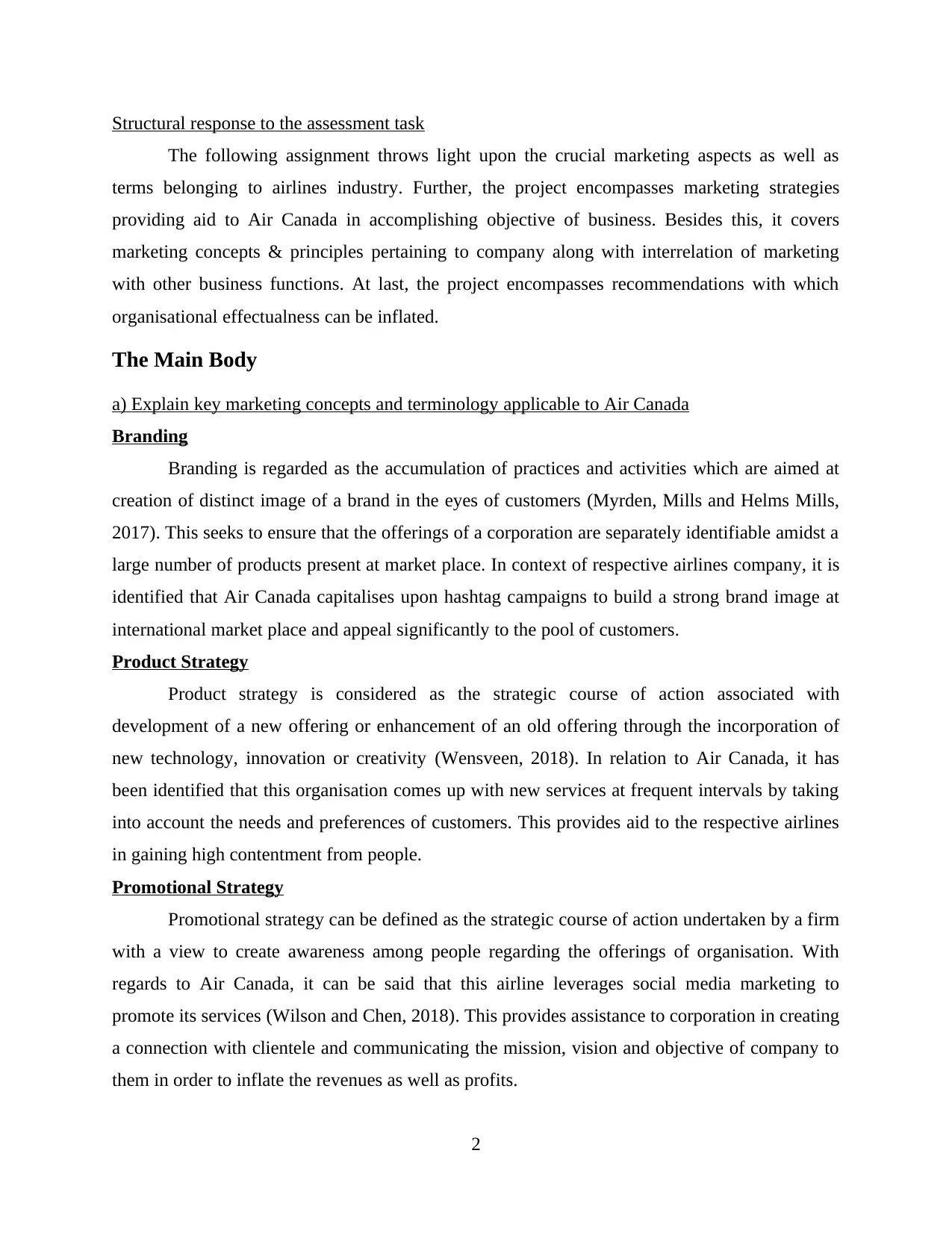
Structural response to the assessment task
The following assignment throws light upon the crucial marketing aspects as well as
terms belonging to airlines industry. Further, the project encompasses marketing strategies
providing aid to Air Canada in accomplishing objective of business. Besides this, it covers
marketing concepts & principles pertaining to company along with interrelation of marketing
with other business functions. At last, the project encompasses recommendations with which
organisational effectualness can be inflated.
The Main Body
a) Explain key marketing concepts and terminology applicable to Air Canada
Branding
Branding is regarded as the accumulation of practices and activities which are aimed at
creation of distinct image of a brand in the eyes of customers (Myrden, Mills and Helms Mills,
2017). This seeks to ensure that the offerings of a corporation are separately identifiable amidst a
large number of products present at market place. In context of respective airlines company, it is
identified that Air Canada capitalises upon hashtag campaigns to build a strong brand image at
international market place and appeal significantly to the pool of customers.
Product Strategy
Product strategy is considered as the strategic course of action associated with
development of a new offering or enhancement of an old offering through the incorporation of
new technology, innovation or creativity (Wensveen, 2018). In relation to Air Canada, it has
been identified that this organisation comes up with new services at frequent intervals by taking
into account the needs and preferences of customers. This provides aid to the respective airlines
in gaining high contentment from people.
Promotional Strategy
Promotional strategy can be defined as the strategic course of action undertaken by a firm
with a view to create awareness among people regarding the offerings of organisation. With
regards to Air Canada, it can be said that this airline leverages social media marketing to
promote its services (Wilson and Chen, 2018). This provides assistance to corporation in creating
a connection with clientele and communicating the mission, vision and objective of company to
them in order to inflate the revenues as well as profits.
2
The following assignment throws light upon the crucial marketing aspects as well as
terms belonging to airlines industry. Further, the project encompasses marketing strategies
providing aid to Air Canada in accomplishing objective of business. Besides this, it covers
marketing concepts & principles pertaining to company along with interrelation of marketing
with other business functions. At last, the project encompasses recommendations with which
organisational effectualness can be inflated.
The Main Body
a) Explain key marketing concepts and terminology applicable to Air Canada
Branding
Branding is regarded as the accumulation of practices and activities which are aimed at
creation of distinct image of a brand in the eyes of customers (Myrden, Mills and Helms Mills,
2017). This seeks to ensure that the offerings of a corporation are separately identifiable amidst a
large number of products present at market place. In context of respective airlines company, it is
identified that Air Canada capitalises upon hashtag campaigns to build a strong brand image at
international market place and appeal significantly to the pool of customers.
Product Strategy
Product strategy is considered as the strategic course of action associated with
development of a new offering or enhancement of an old offering through the incorporation of
new technology, innovation or creativity (Wensveen, 2018). In relation to Air Canada, it has
been identified that this organisation comes up with new services at frequent intervals by taking
into account the needs and preferences of customers. This provides aid to the respective airlines
in gaining high contentment from people.
Promotional Strategy
Promotional strategy can be defined as the strategic course of action undertaken by a firm
with a view to create awareness among people regarding the offerings of organisation. With
regards to Air Canada, it can be said that this airline leverages social media marketing to
promote its services (Wilson and Chen, 2018). This provides assistance to corporation in creating
a connection with clientele and communicating the mission, vision and objective of company to
them in order to inflate the revenues as well as profits.
2
Paraphrase This Document
Need a fresh take? Get an instant paraphrase of this document with our AI Paraphraser
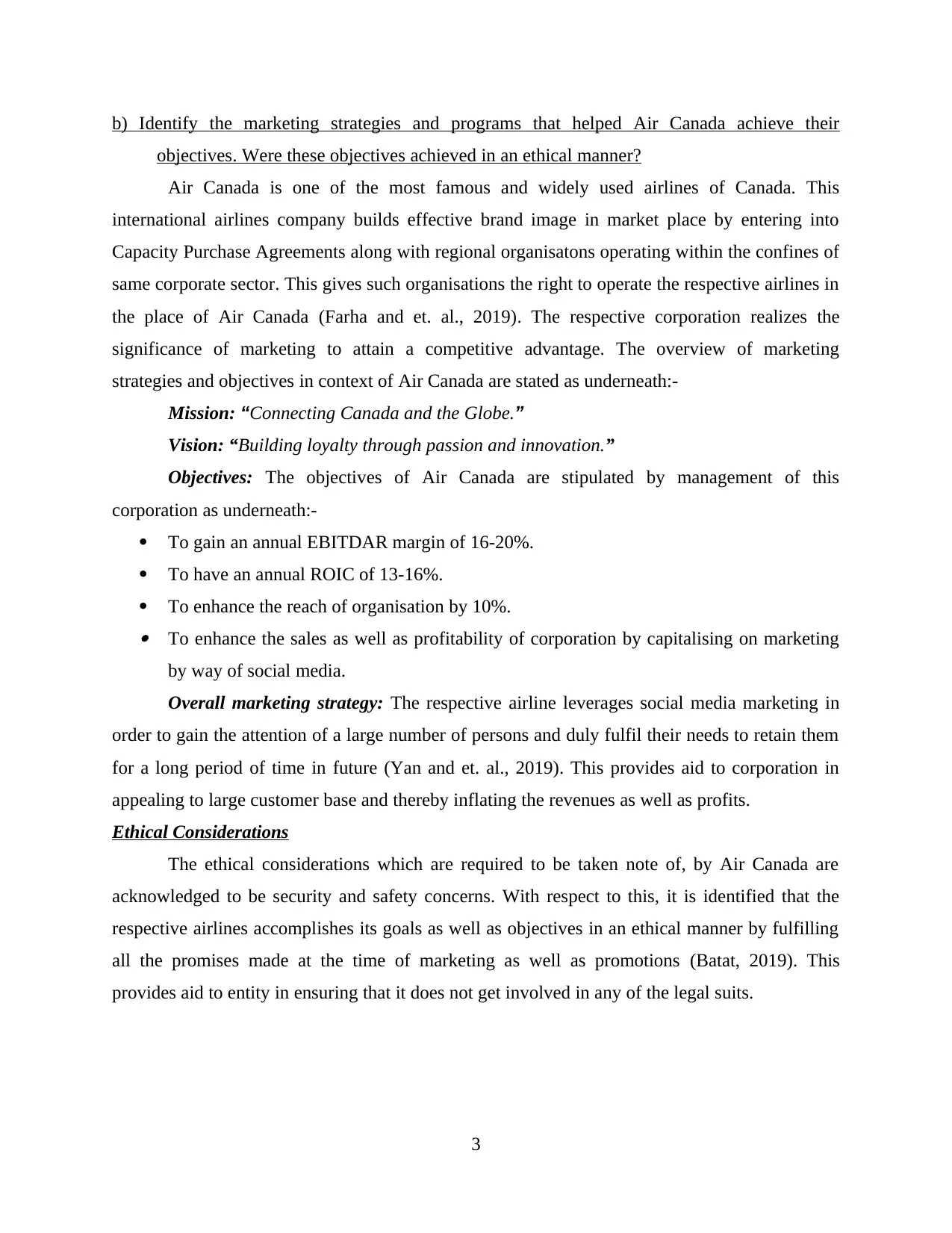
b) Identify the marketing strategies and programs that helped Air Canada achieve their
objectives. Were these objectives achieved in an ethical manner?
Air Canada is one of the most famous and widely used airlines of Canada. This
international airlines company builds effective brand image in market place by entering into
Capacity Purchase Agreements along with regional organisatons operating within the confines of
same corporate sector. This gives such organisations the right to operate the respective airlines in
the place of Air Canada (Farha and et. al., 2019). The respective corporation realizes the
significance of marketing to attain a competitive advantage. The overview of marketing
strategies and objectives in context of Air Canada are stated as underneath:-
Mission: “Connecting Canada and the Globe.”
Vision: “Building loyalty through passion and innovation.”
Objectives: The objectives of Air Canada are stipulated by management of this
corporation as underneath:-
To gain an annual EBITDAR margin of 16-20%.
To have an annual ROIC of 13-16%.
To enhance the reach of organisation by 10%. To enhance the sales as well as profitability of corporation by capitalising on marketing
by way of social media.
Overall marketing strategy: The respective airline leverages social media marketing in
order to gain the attention of a large number of persons and duly fulfil their needs to retain them
for a long period of time in future (Yan and et. al., 2019). This provides aid to corporation in
appealing to large customer base and thereby inflating the revenues as well as profits.
Ethical Considerations
The ethical considerations which are required to be taken note of, by Air Canada are
acknowledged to be security and safety concerns. With respect to this, it is identified that the
respective airlines accomplishes its goals as well as objectives in an ethical manner by fulfilling
all the promises made at the time of marketing as well as promotions (Batat, 2019). This
provides aid to entity in ensuring that it does not get involved in any of the legal suits.
3
objectives. Were these objectives achieved in an ethical manner?
Air Canada is one of the most famous and widely used airlines of Canada. This
international airlines company builds effective brand image in market place by entering into
Capacity Purchase Agreements along with regional organisatons operating within the confines of
same corporate sector. This gives such organisations the right to operate the respective airlines in
the place of Air Canada (Farha and et. al., 2019). The respective corporation realizes the
significance of marketing to attain a competitive advantage. The overview of marketing
strategies and objectives in context of Air Canada are stated as underneath:-
Mission: “Connecting Canada and the Globe.”
Vision: “Building loyalty through passion and innovation.”
Objectives: The objectives of Air Canada are stipulated by management of this
corporation as underneath:-
To gain an annual EBITDAR margin of 16-20%.
To have an annual ROIC of 13-16%.
To enhance the reach of organisation by 10%. To enhance the sales as well as profitability of corporation by capitalising on marketing
by way of social media.
Overall marketing strategy: The respective airline leverages social media marketing in
order to gain the attention of a large number of persons and duly fulfil their needs to retain them
for a long period of time in future (Yan and et. al., 2019). This provides aid to corporation in
appealing to large customer base and thereby inflating the revenues as well as profits.
Ethical Considerations
The ethical considerations which are required to be taken note of, by Air Canada are
acknowledged to be security and safety concerns. With respect to this, it is identified that the
respective airlines accomplishes its goals as well as objectives in an ethical manner by fulfilling
all the promises made at the time of marketing as well as promotions (Batat, 2019). This
provides aid to entity in ensuring that it does not get involved in any of the legal suits.
3
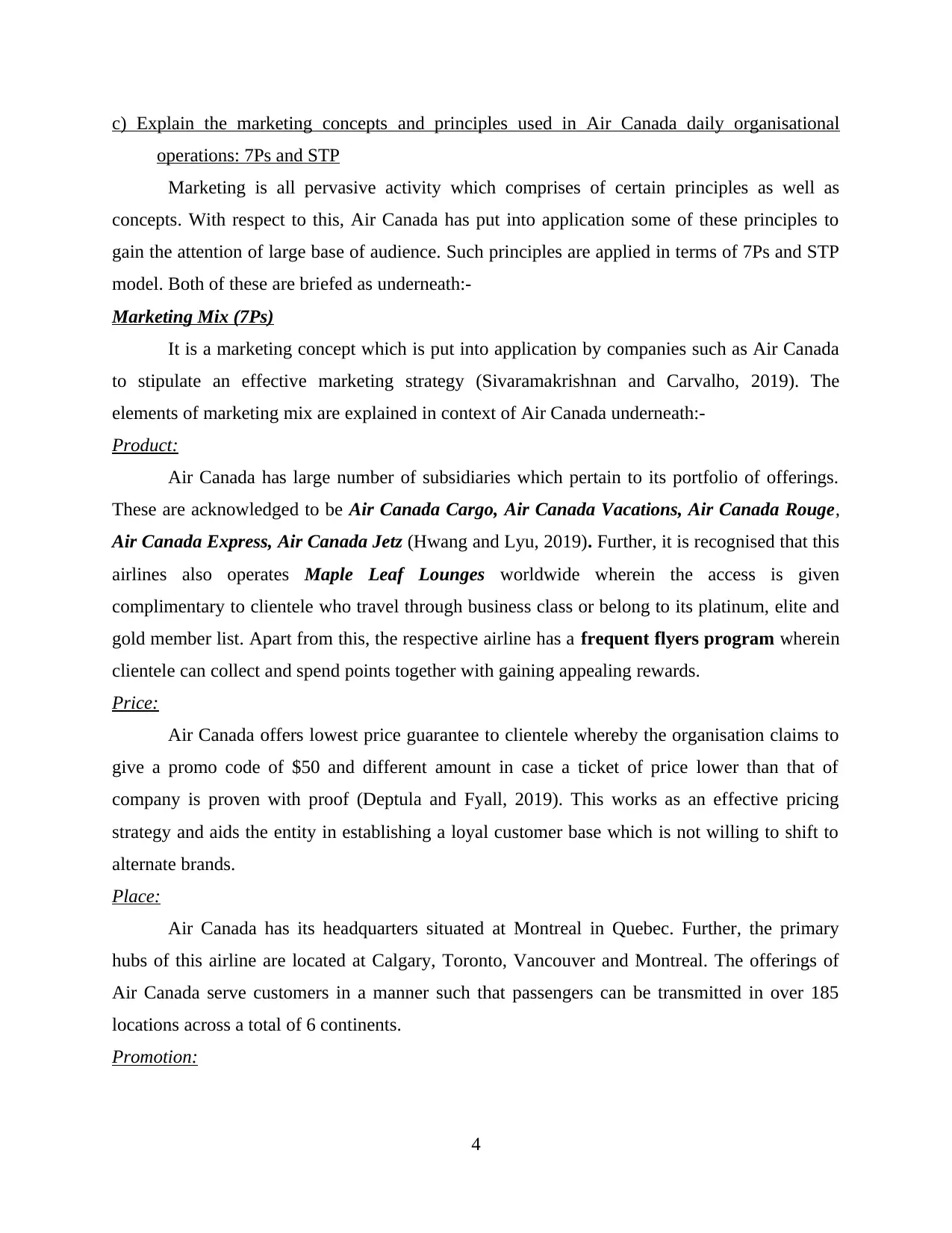
c) Explain the marketing concepts and principles used in Air Canada daily organisational
operations: 7Ps and STP
Marketing is all pervasive activity which comprises of certain principles as well as
concepts. With respect to this, Air Canada has put into application some of these principles to
gain the attention of large base of audience. Such principles are applied in terms of 7Ps and STP
model. Both of these are briefed as underneath:-
Marketing Mix (7Ps)
It is a marketing concept which is put into application by companies such as Air Canada
to stipulate an effective marketing strategy (Sivaramakrishnan and Carvalho, 2019). The
elements of marketing mix are explained in context of Air Canada underneath:-
Product:
Air Canada has large number of subsidiaries which pertain to its portfolio of offerings.
These are acknowledged to be Air Canada Cargo, Air Canada Vacations, Air Canada Rouge,
Air Canada Express, Air Canada Jetz (Hwang and Lyu, 2019). Further, it is recognised that this
airlines also operates Maple Leaf Lounges worldwide wherein the access is given
complimentary to clientele who travel through business class or belong to its platinum, elite and
gold member list. Apart from this, the respective airline has a frequent flyers program wherein
clientele can collect and spend points together with gaining appealing rewards.
Price:
Air Canada offers lowest price guarantee to clientele whereby the organisation claims to
give a promo code of $50 and different amount in case a ticket of price lower than that of
company is proven with proof (Deptula and Fyall, 2019). This works as an effective pricing
strategy and aids the entity in establishing a loyal customer base which is not willing to shift to
alternate brands.
Place:
Air Canada has its headquarters situated at Montreal in Quebec. Further, the primary
hubs of this airline are located at Calgary, Toronto, Vancouver and Montreal. The offerings of
Air Canada serve customers in a manner such that passengers can be transmitted in over 185
locations across a total of 6 continents.
Promotion:
4
operations: 7Ps and STP
Marketing is all pervasive activity which comprises of certain principles as well as
concepts. With respect to this, Air Canada has put into application some of these principles to
gain the attention of large base of audience. Such principles are applied in terms of 7Ps and STP
model. Both of these are briefed as underneath:-
Marketing Mix (7Ps)
It is a marketing concept which is put into application by companies such as Air Canada
to stipulate an effective marketing strategy (Sivaramakrishnan and Carvalho, 2019). The
elements of marketing mix are explained in context of Air Canada underneath:-
Product:
Air Canada has large number of subsidiaries which pertain to its portfolio of offerings.
These are acknowledged to be Air Canada Cargo, Air Canada Vacations, Air Canada Rouge,
Air Canada Express, Air Canada Jetz (Hwang and Lyu, 2019). Further, it is recognised that this
airlines also operates Maple Leaf Lounges worldwide wherein the access is given
complimentary to clientele who travel through business class or belong to its platinum, elite and
gold member list. Apart from this, the respective airline has a frequent flyers program wherein
clientele can collect and spend points together with gaining appealing rewards.
Price:
Air Canada offers lowest price guarantee to clientele whereby the organisation claims to
give a promo code of $50 and different amount in case a ticket of price lower than that of
company is proven with proof (Deptula and Fyall, 2019). This works as an effective pricing
strategy and aids the entity in establishing a loyal customer base which is not willing to shift to
alternate brands.
Place:
Air Canada has its headquarters situated at Montreal in Quebec. Further, the primary
hubs of this airline are located at Calgary, Toronto, Vancouver and Montreal. The offerings of
Air Canada serve customers in a manner such that passengers can be transmitted in over 185
locations across a total of 6 continents.
Promotion:
4
⊘ This is a preview!⊘
Do you want full access?
Subscribe today to unlock all pages.

Trusted by 1+ million students worldwide
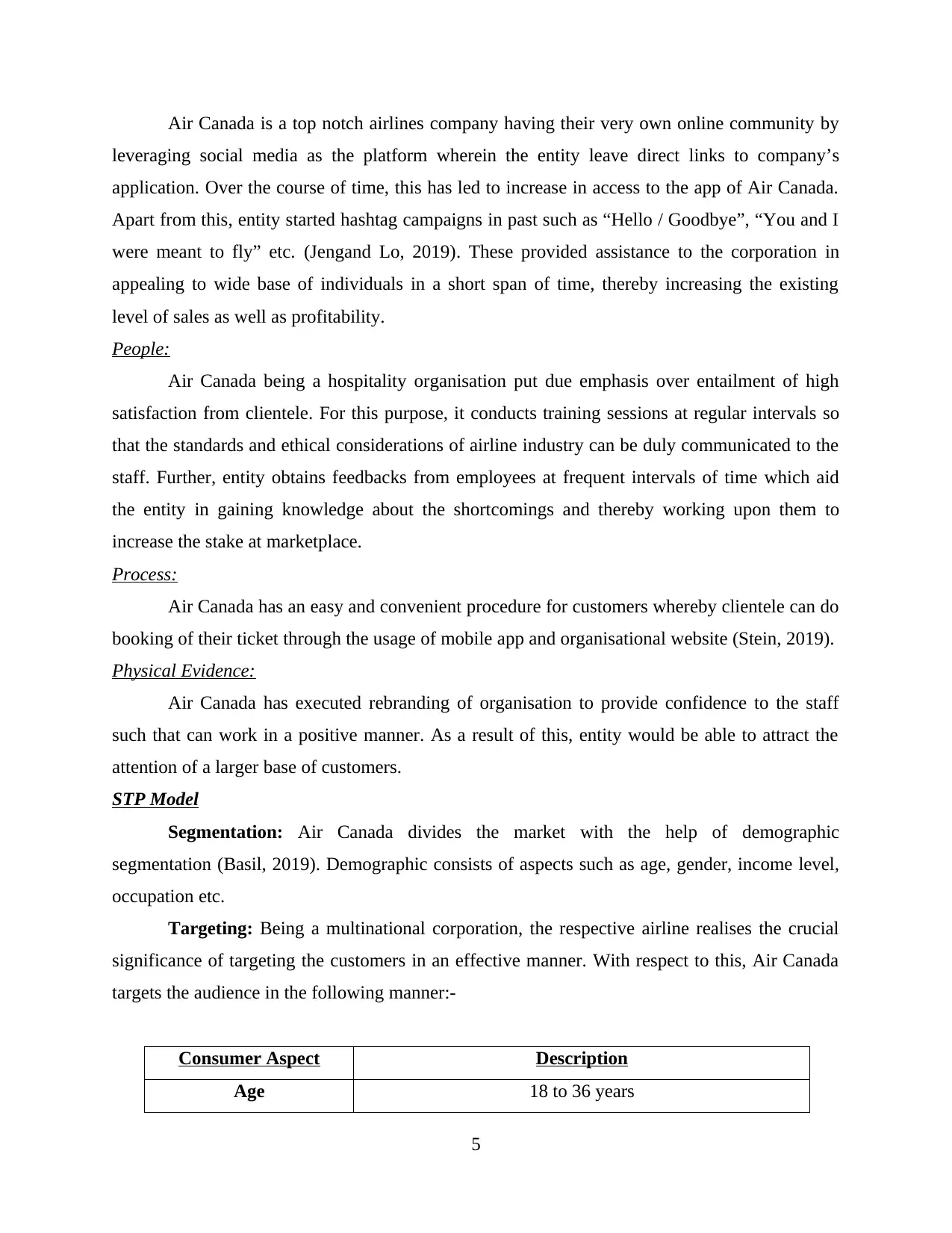
Air Canada is a top notch airlines company having their very own online community by
leveraging social media as the platform wherein the entity leave direct links to company’s
application. Over the course of time, this has led to increase in access to the app of Air Canada.
Apart from this, entity started hashtag campaigns in past such as “Hello / Goodbye”, “You and I
were meant to fly” etc. (Jengand Lo, 2019). These provided assistance to the corporation in
appealing to wide base of individuals in a short span of time, thereby increasing the existing
level of sales as well as profitability.
People:
Air Canada being a hospitality organisation put due emphasis over entailment of high
satisfaction from clientele. For this purpose, it conducts training sessions at regular intervals so
that the standards and ethical considerations of airline industry can be duly communicated to the
staff. Further, entity obtains feedbacks from employees at frequent intervals of time which aid
the entity in gaining knowledge about the shortcomings and thereby working upon them to
increase the stake at marketplace.
Process:
Air Canada has an easy and convenient procedure for customers whereby clientele can do
booking of their ticket through the usage of mobile app and organisational website (Stein, 2019).
Physical Evidence:
Air Canada has executed rebranding of organisation to provide confidence to the staff
such that can work in a positive manner. As a result of this, entity would be able to attract the
attention of a larger base of customers.
STP Model
Segmentation: Air Canada divides the market with the help of demographic
segmentation (Basil, 2019). Demographic consists of aspects such as age, gender, income level,
occupation etc.
Targeting: Being a multinational corporation, the respective airline realises the crucial
significance of targeting the customers in an effective manner. With respect to this, Air Canada
targets the audience in the following manner:-
Consumer Aspect Description
Age 18 to 36 years
5
leveraging social media as the platform wherein the entity leave direct links to company’s
application. Over the course of time, this has led to increase in access to the app of Air Canada.
Apart from this, entity started hashtag campaigns in past such as “Hello / Goodbye”, “You and I
were meant to fly” etc. (Jengand Lo, 2019). These provided assistance to the corporation in
appealing to wide base of individuals in a short span of time, thereby increasing the existing
level of sales as well as profitability.
People:
Air Canada being a hospitality organisation put due emphasis over entailment of high
satisfaction from clientele. For this purpose, it conducts training sessions at regular intervals so
that the standards and ethical considerations of airline industry can be duly communicated to the
staff. Further, entity obtains feedbacks from employees at frequent intervals of time which aid
the entity in gaining knowledge about the shortcomings and thereby working upon them to
increase the stake at marketplace.
Process:
Air Canada has an easy and convenient procedure for customers whereby clientele can do
booking of their ticket through the usage of mobile app and organisational website (Stein, 2019).
Physical Evidence:
Air Canada has executed rebranding of organisation to provide confidence to the staff
such that can work in a positive manner. As a result of this, entity would be able to attract the
attention of a larger base of customers.
STP Model
Segmentation: Air Canada divides the market with the help of demographic
segmentation (Basil, 2019). Demographic consists of aspects such as age, gender, income level,
occupation etc.
Targeting: Being a multinational corporation, the respective airline realises the crucial
significance of targeting the customers in an effective manner. With respect to this, Air Canada
targets the audience in the following manner:-
Consumer Aspect Description
Age 18 to 36 years
5
Paraphrase This Document
Need a fresh take? Get an instant paraphrase of this document with our AI Paraphraser
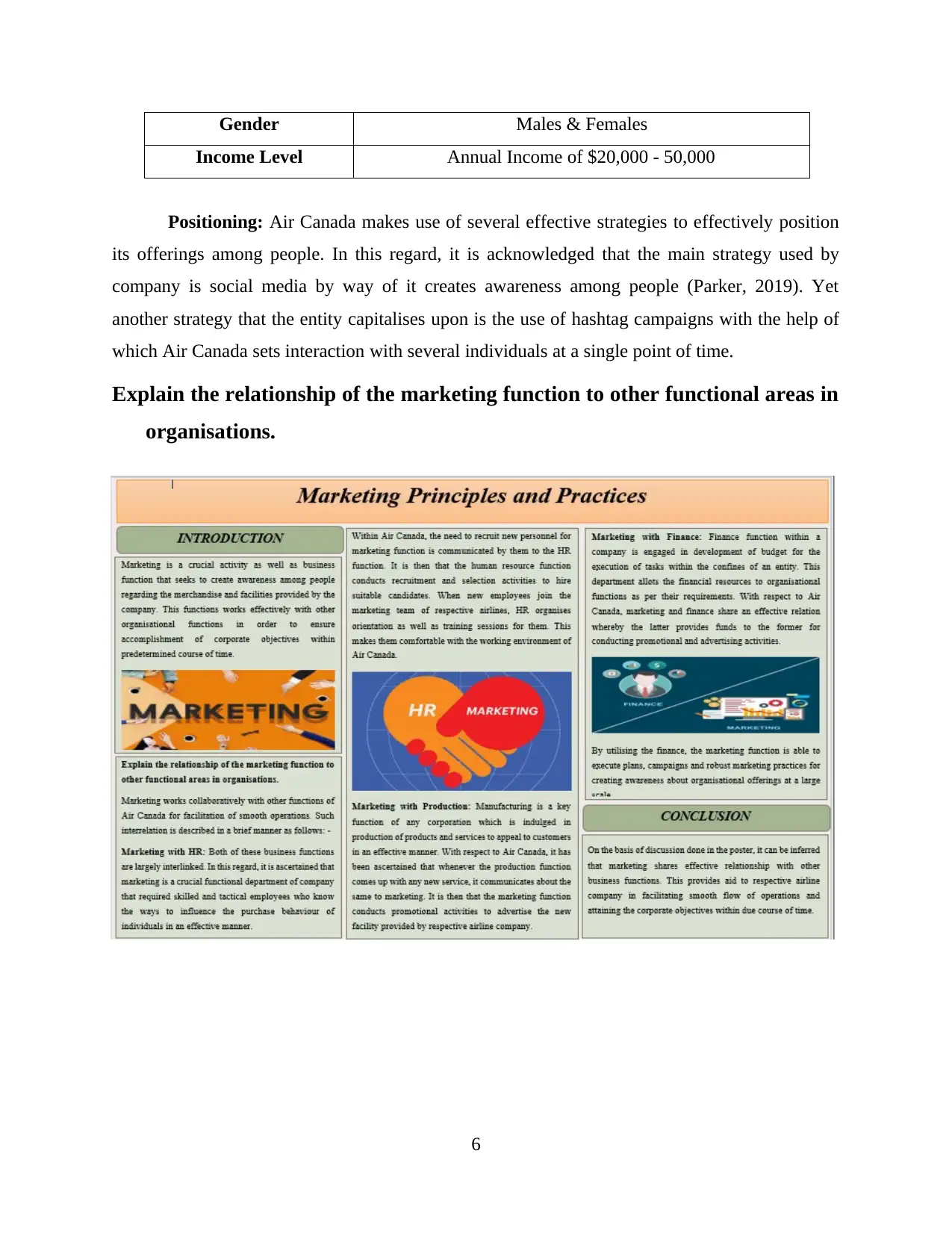
Gender Males & Females
Income Level Annual Income of $20,000 - 50,000
Positioning: Air Canada makes use of several effective strategies to effectively position
its offerings among people. In this regard, it is acknowledged that the main strategy used by
company is social media by way of it creates awareness among people (Parker, 2019). Yet
another strategy that the entity capitalises upon is the use of hashtag campaigns with the help of
which Air Canada sets interaction with several individuals at a single point of time.
Explain the relationship of the marketing function to other functional areas in
organisations.
6
Income Level Annual Income of $20,000 - 50,000
Positioning: Air Canada makes use of several effective strategies to effectively position
its offerings among people. In this regard, it is acknowledged that the main strategy used by
company is social media by way of it creates awareness among people (Parker, 2019). Yet
another strategy that the entity capitalises upon is the use of hashtag campaigns with the help of
which Air Canada sets interaction with several individuals at a single point of time.
Explain the relationship of the marketing function to other functional areas in
organisations.
6
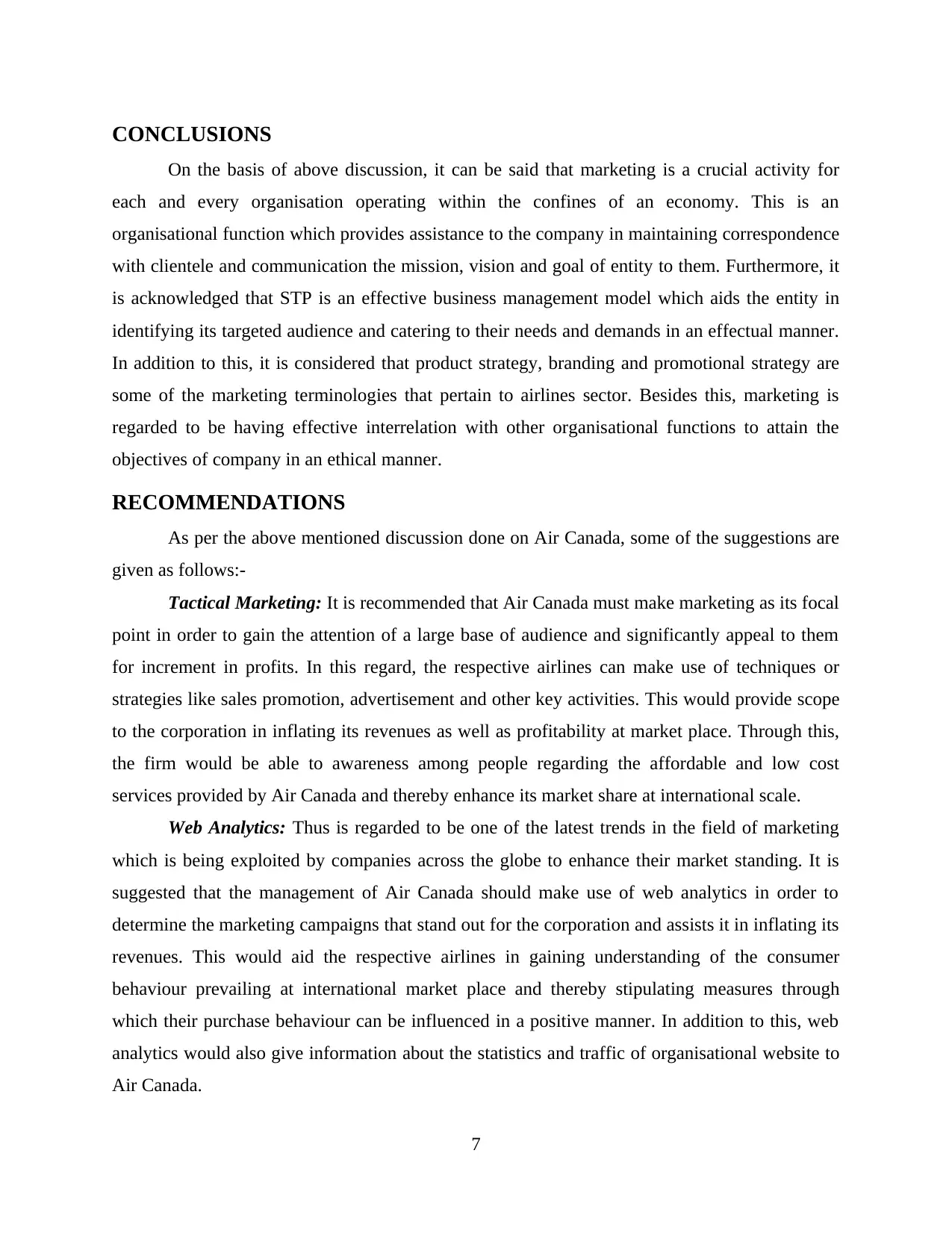
CONCLUSIONS
On the basis of above discussion, it can be said that marketing is a crucial activity for
each and every organisation operating within the confines of an economy. This is an
organisational function which provides assistance to the company in maintaining correspondence
with clientele and communication the mission, vision and goal of entity to them. Furthermore, it
is acknowledged that STP is an effective business management model which aids the entity in
identifying its targeted audience and catering to their needs and demands in an effectual manner.
In addition to this, it is considered that product strategy, branding and promotional strategy are
some of the marketing terminologies that pertain to airlines sector. Besides this, marketing is
regarded to be having effective interrelation with other organisational functions to attain the
objectives of company in an ethical manner.
RECOMMENDATIONS
As per the above mentioned discussion done on Air Canada, some of the suggestions are
given as follows:-
Tactical Marketing: It is recommended that Air Canada must make marketing as its focal
point in order to gain the attention of a large base of audience and significantly appeal to them
for increment in profits. In this regard, the respective airlines can make use of techniques or
strategies like sales promotion, advertisement and other key activities. This would provide scope
to the corporation in inflating its revenues as well as profitability at market place. Through this,
the firm would be able to awareness among people regarding the affordable and low cost
services provided by Air Canada and thereby enhance its market share at international scale.
Web Analytics: Thus is regarded to be one of the latest trends in the field of marketing
which is being exploited by companies across the globe to enhance their market standing. It is
suggested that the management of Air Canada should make use of web analytics in order to
determine the marketing campaigns that stand out for the corporation and assists it in inflating its
revenues. This would aid the respective airlines in gaining understanding of the consumer
behaviour prevailing at international market place and thereby stipulating measures through
which their purchase behaviour can be influenced in a positive manner. In addition to this, web
analytics would also give information about the statistics and traffic of organisational website to
Air Canada.
7
On the basis of above discussion, it can be said that marketing is a crucial activity for
each and every organisation operating within the confines of an economy. This is an
organisational function which provides assistance to the company in maintaining correspondence
with clientele and communication the mission, vision and goal of entity to them. Furthermore, it
is acknowledged that STP is an effective business management model which aids the entity in
identifying its targeted audience and catering to their needs and demands in an effectual manner.
In addition to this, it is considered that product strategy, branding and promotional strategy are
some of the marketing terminologies that pertain to airlines sector. Besides this, marketing is
regarded to be having effective interrelation with other organisational functions to attain the
objectives of company in an ethical manner.
RECOMMENDATIONS
As per the above mentioned discussion done on Air Canada, some of the suggestions are
given as follows:-
Tactical Marketing: It is recommended that Air Canada must make marketing as its focal
point in order to gain the attention of a large base of audience and significantly appeal to them
for increment in profits. In this regard, the respective airlines can make use of techniques or
strategies like sales promotion, advertisement and other key activities. This would provide scope
to the corporation in inflating its revenues as well as profitability at market place. Through this,
the firm would be able to awareness among people regarding the affordable and low cost
services provided by Air Canada and thereby enhance its market share at international scale.
Web Analytics: Thus is regarded to be one of the latest trends in the field of marketing
which is being exploited by companies across the globe to enhance their market standing. It is
suggested that the management of Air Canada should make use of web analytics in order to
determine the marketing campaigns that stand out for the corporation and assists it in inflating its
revenues. This would aid the respective airlines in gaining understanding of the consumer
behaviour prevailing at international market place and thereby stipulating measures through
which their purchase behaviour can be influenced in a positive manner. In addition to this, web
analytics would also give information about the statistics and traffic of organisational website to
Air Canada.
7
⊘ This is a preview!⊘
Do you want full access?
Subscribe today to unlock all pages.

Trusted by 1+ million students worldwide
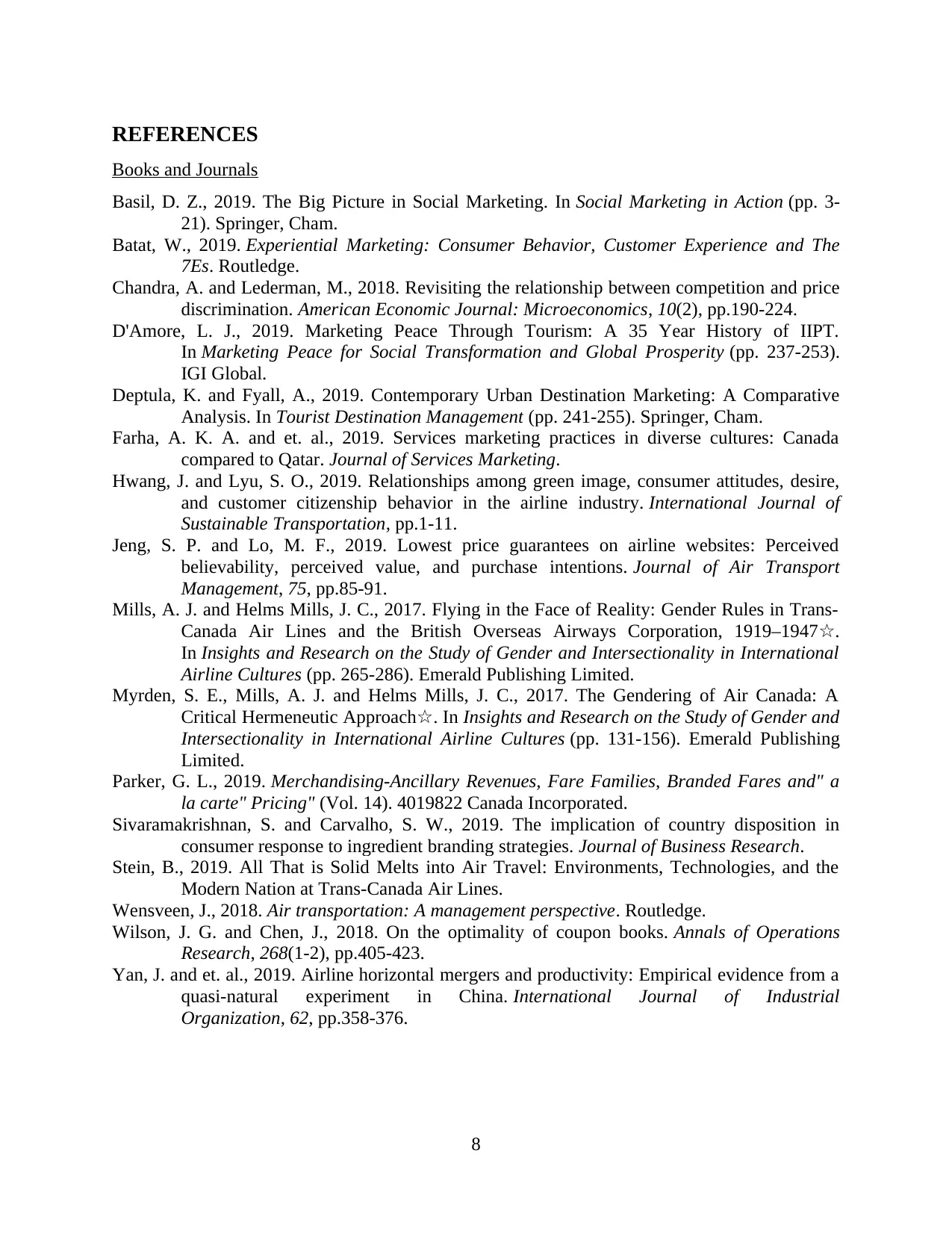
REFERENCES
Books and Journals
Basil, D. Z., 2019. The Big Picture in Social Marketing. In Social Marketing in Action (pp. 3-
21). Springer, Cham.
Batat, W., 2019. Experiential Marketing: Consumer Behavior, Customer Experience and The
7Es. Routledge.
Chandra, A. and Lederman, M., 2018. Revisiting the relationship between competition and price
discrimination. American Economic Journal: Microeconomics, 10(2), pp.190-224.
D'Amore, L. J., 2019. Marketing Peace Through Tourism: A 35 Year History of IIPT.
In Marketing Peace for Social Transformation and Global Prosperity (pp. 237-253).
IGI Global.
Deptula, K. and Fyall, A., 2019. Contemporary Urban Destination Marketing: A Comparative
Analysis. In Tourist Destination Management (pp. 241-255). Springer, Cham.
Farha, A. K. A. and et. al., 2019. Services marketing practices in diverse cultures: Canada
compared to Qatar. Journal of Services Marketing.
Hwang, J. and Lyu, S. O., 2019. Relationships among green image, consumer attitudes, desire,
and customer citizenship behavior in the airline industry. International Journal of
Sustainable Transportation, pp.1-11.
Jeng, S. P. and Lo, M. F., 2019. Lowest price guarantees on airline websites: Perceived
believability, perceived value, and purchase intentions. Journal of Air Transport
Management, 75, pp.85-91.
Mills, A. J. and Helms Mills, J. C., 2017. Flying in the Face of Reality: Gender Rules in Trans-
Canada Air Lines and the British Overseas Airways Corporation, 1919–1947 .☆
In Insights and Research on the Study of Gender and Intersectionality in International
Airline Cultures (pp. 265-286). Emerald Publishing Limited.
Myrden, S. E., Mills, A. J. and Helms Mills, J. C., 2017. The Gendering of Air Canada: A
Critical Hermeneutic Approach . In☆ Insights and Research on the Study of Gender and
Intersectionality in International Airline Cultures (pp. 131-156). Emerald Publishing
Limited.
Parker, G. L., 2019. Merchandising-Ancillary Revenues, Fare Families, Branded Fares and" a
la carte" Pricing" (Vol. 14). 4019822 Canada Incorporated.
Sivaramakrishnan, S. and Carvalho, S. W., 2019. The implication of country disposition in
consumer response to ingredient branding strategies. Journal of Business Research.
Stein, B., 2019. All That is Solid Melts into Air Travel: Environments, Technologies, and the
Modern Nation at Trans-Canada Air Lines.
Wensveen, J., 2018. Air transportation: A management perspective. Routledge.
Wilson, J. G. and Chen, J., 2018. On the optimality of coupon books. Annals of Operations
Research, 268(1-2), pp.405-423.
Yan, J. and et. al., 2019. Airline horizontal mergers and productivity: Empirical evidence from a
quasi-natural experiment in China. International Journal of Industrial
Organization, 62, pp.358-376.
8
Books and Journals
Basil, D. Z., 2019. The Big Picture in Social Marketing. In Social Marketing in Action (pp. 3-
21). Springer, Cham.
Batat, W., 2019. Experiential Marketing: Consumer Behavior, Customer Experience and The
7Es. Routledge.
Chandra, A. and Lederman, M., 2018. Revisiting the relationship between competition and price
discrimination. American Economic Journal: Microeconomics, 10(2), pp.190-224.
D'Amore, L. J., 2019. Marketing Peace Through Tourism: A 35 Year History of IIPT.
In Marketing Peace for Social Transformation and Global Prosperity (pp. 237-253).
IGI Global.
Deptula, K. and Fyall, A., 2019. Contemporary Urban Destination Marketing: A Comparative
Analysis. In Tourist Destination Management (pp. 241-255). Springer, Cham.
Farha, A. K. A. and et. al., 2019. Services marketing practices in diverse cultures: Canada
compared to Qatar. Journal of Services Marketing.
Hwang, J. and Lyu, S. O., 2019. Relationships among green image, consumer attitudes, desire,
and customer citizenship behavior in the airline industry. International Journal of
Sustainable Transportation, pp.1-11.
Jeng, S. P. and Lo, M. F., 2019. Lowest price guarantees on airline websites: Perceived
believability, perceived value, and purchase intentions. Journal of Air Transport
Management, 75, pp.85-91.
Mills, A. J. and Helms Mills, J. C., 2017. Flying in the Face of Reality: Gender Rules in Trans-
Canada Air Lines and the British Overseas Airways Corporation, 1919–1947 .☆
In Insights and Research on the Study of Gender and Intersectionality in International
Airline Cultures (pp. 265-286). Emerald Publishing Limited.
Myrden, S. E., Mills, A. J. and Helms Mills, J. C., 2017. The Gendering of Air Canada: A
Critical Hermeneutic Approach . In☆ Insights and Research on the Study of Gender and
Intersectionality in International Airline Cultures (pp. 131-156). Emerald Publishing
Limited.
Parker, G. L., 2019. Merchandising-Ancillary Revenues, Fare Families, Branded Fares and" a
la carte" Pricing" (Vol. 14). 4019822 Canada Incorporated.
Sivaramakrishnan, S. and Carvalho, S. W., 2019. The implication of country disposition in
consumer response to ingredient branding strategies. Journal of Business Research.
Stein, B., 2019. All That is Solid Melts into Air Travel: Environments, Technologies, and the
Modern Nation at Trans-Canada Air Lines.
Wensveen, J., 2018. Air transportation: A management perspective. Routledge.
Wilson, J. G. and Chen, J., 2018. On the optimality of coupon books. Annals of Operations
Research, 268(1-2), pp.405-423.
Yan, J. and et. al., 2019. Airline horizontal mergers and productivity: Empirical evidence from a
quasi-natural experiment in China. International Journal of Industrial
Organization, 62, pp.358-376.
8
1 out of 10
Related Documents
Your All-in-One AI-Powered Toolkit for Academic Success.
+13062052269
info@desklib.com
Available 24*7 on WhatsApp / Email
![[object Object]](/_next/static/media/star-bottom.7253800d.svg)
Unlock your academic potential
Copyright © 2020–2025 A2Z Services. All Rights Reserved. Developed and managed by ZUCOL.





